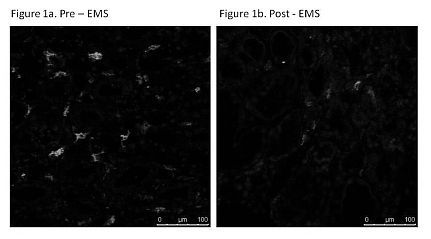Strategy for Eliminating Passenger Leukocytes in Human Renal Allografts, A
Breonics, Inc., Albany
University Medical Center, Utrecht, Netherlands
Meeting: 2013 American Transplant Congress
Abstract number: A643
Transplantation is unique immunologically due to both donor and recipient antigen presenting cells being present at reperfusion. Dendritic cells (DC) are a potent type of professional antigen presenting cells. As part of their normal immune surveillance, DC are trapped within the renal parenchyma at the time of organ procurement. Upon reimplantation, the DC migrate out of the allograft into secondary lymphatics where recipient immune cells encounter the foreign antigens on the passenger leukocytes via direct antigen presentation and from then on there is the up-hill battle to prevent rejection. If strategies can be developed that minimizes this initial allorecognition, there could be a positive impact on outcomes. Using an acellular, near-normothermic perfusion technology, called Exsanguinous Metabolic Support (EMS) we evaluated the feasibility of removing the DC from human kidneys. Methods – Human allografts deemed to be non-transplantable according to standard criteria were procured for this study. The human kidneys were received on ice, flushed with EMS solution (32°C) and placed on perfusion. An initial biopsy was taken before and again after the period of EMS perfusion (either 24 or 48 hours). Frozen sections were made from representative sections of the kidneys. The number and location of the DC within the kidneys were determined using an indirect immunofluorescence assay with CD209 (DC-sign) antibody and secondary antibody of Alexafluor488, along fluoroshield plus DAPI. Results – There was a significant reduction in the number of resident DC following either 24 or 48 hours of EMS perfusion.
| Pre | Post | |
| Kidney DC+ ∗ | 12.78±9.1 | 6.06±3.67 |
| Perfusate DC† | 0 | 1.02 x10^6 |

This finding is mirrored by the increasing concentration of DC found in the circulating EMS solution after perfusion. Conclusion – This study demonstrates the initial feasibility of depleting renal allografts of passenger leukocytes pretransplant during a period of warm acellular perfusion. We are currently evaluating non-toxic adjunct techniques for further enhancement of depletion.
To cite this abstract in AMA style:
Brasile L, Glowacki P, Henry N, Stubenitsky B. Strategy for Eliminating Passenger Leukocytes in Human Renal Allografts, A [abstract]. Am J Transplant. 2013; 13 (suppl 5). https://atcmeetingabstracts.com/abstract/strategy-for-eliminating-passenger-leukocytes-in-human-renal-allografts-a/. Accessed December 21, 2025.« Back to 2013 American Transplant Congress
